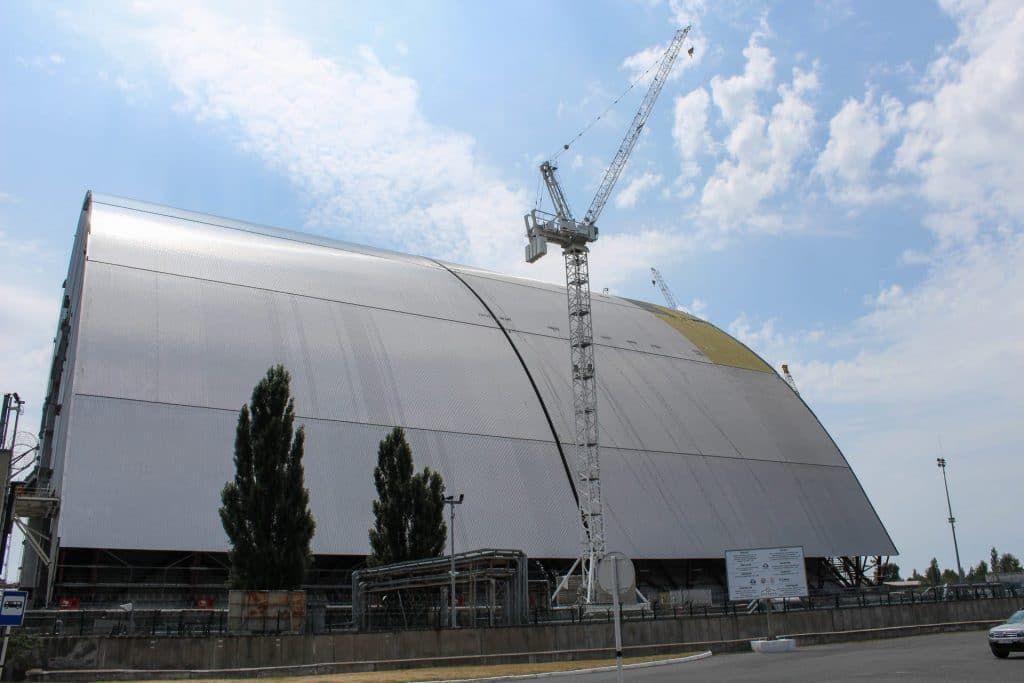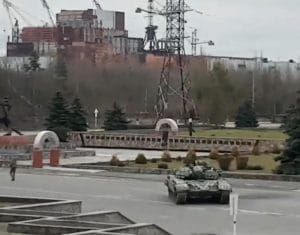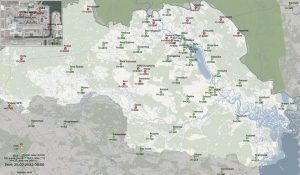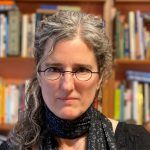Russian forces now control Chernobyl, inviting speculation and uncertainty
By Susan D’Agostino | February 25, 2022
 New sarcophagus, Chernobyl power plant. Credit: Timon91. Accessed via Flickr. CC BY-NC-SA 2.0.
New sarcophagus, Chernobyl power plant. Credit: Timon91. Accessed via Flickr. CC BY-NC-SA 2.0.
Editor’s note: This is a developing story. For full Bulletin coverage of the Ukraine crisis, click here.
Yesterday, Russian forces seized control of the defunct Chernobyl Nuclear Power Plant, the still-radioactive site of the world’s worst nuclear disaster. The plant, along with the approximately 1,000-square miles around it known as the Chernobyl Exclusion Zone, supports ongoing work focused on nuclear waste management and storage. The takeover was part of Russian President Vladimir Putin’s multi-pronged assault on Ukraine, which began on Thursday.

Though the International Atomic Energy Agency, a United Nations watchdog, reported that there have been “no casualties nor destruction” at Chernobyl, experts and the public are now at work attempting to understand the potential risks posed by the takeover. While some offer measured responses concerning the potential for human and ecological disaster, others express alarm. Many posit theories for why Russia sought to seize control of Chernobyl, including using the site as a base, for a potential act of terrorism, or for the symbolic “win” it may represent.
Igor Konashenkov, a spokesperson for Russian Military of Defense, said in a statement that the Ukrainian staff “continues to service the facilities in a routine mode and monitor the radioactive situation.” Konashenkov did not indicate that Russian soldiers were holding the workers hostage, as Kateryna Pavlova, Chernobyl’s Head of the Department for International Cooperation and Public Relations, told the Bulletin yesterday.
“The most dangerous part is that we lost control,” Pavlova said. “Some part of the staff from Chernobyl Nuclear Power Plant and National Guard have been kidnapped. They can’t connect. They can’t report.”
White House Press Secretary, Jen Psaki, later expressed similar concern: “This unlawful and dangerous hostage-taking, which could upend the routine civil service efforts required to maintain and protect the nuclear waste facilities, is obviously incredibly alarming. We condemn it, and we request their release.”

Expert views of the potential risk have changed since the news broke. For example, yesterday the American Nuclear Society wrote in a tweet that the hostilities in the region “have not resulted in any additional radiological risk.” And Edwin Lyman, director of nuclear power safety at the Union of Concerned Scientists in Washington, said, “I can’t imagine how it would be in Russia’s interest to allow any facilities at Chernobyl to be damaged.”
Yet this morning, the State Nuclear Regulatory Inspectorate of Ukraine reported that radiation levels in the Chernobyl Exclusion Zone were “exceeded at a significant number of observation points” since Russian forces assumed control. The Ukrainian regulatory body attributed the excessive levels to the “disturbance of the top layer of soil from movement of a large number of radio heavy military” and an “increase of air pollution.”
“But now it is currently impossible to establish the reasons for the change in the radiation background in the exclusion zone because of the occupation and military fight in this territory,” the agency’s website said.
A Russian defense ministry official has disputed the claim of excessive radiation levels.
“It is impossible to say that the Chernobyl nuclear power plant is safe after a totally pointless attack by the Russians,” Mykhailo Podolyak, an adviser to the Ukrainian presidential office told Reuters. “This is one of the most serious threats in Europe today.”
International Atomic Energy Agency Director General Rafael Mariano Grossi also expressed “grave concern” and appealed for “maximum restraint to avoid any action that may put the country’s nuclear facilities at risk.”
Chernobyl sits along a short path from the Russia-Ukraine border to Ukraine’s capital. Pavlova, who described the takeover as a “psychological and humanitarian disaster,” notes that Chernobyl’s facilities and location might have been part of the allure. “We have houses where they can stay and leave. It could be their base,” Pavlova said. “It’s very close to Kyiv—only 140 kilometers. The airport is also nearby. It’s a very good location to bring their troops.”
The stricken reactor has been entombed in a sarcophagus—a steel and concrete coffin-like structure—since 1986. In 2016, another structure—known as New Safe Confinement, which is “strong enough to withstand a tornado” and designed to last 100 years, according to the European Bank for Reconstruction and Development—was placed over the sarcophagus. The New Safe Confinement was funded by more than 30 countries at a cost of $1.5 billion.
Still, the Ukrainian Ministry of Foreign Affairs warned that the Russian takeover “may cause another ecological disaster” and that if the war continues, Chernobyl “can happen again in 2022.”
Others were less concerned. “[T]he bigger risk comes from the potential for fighting around Ukraine’s four active nuclear power plants, which contain 15 separate reactors and generated over half the country’s electricity in 2020,” James M. Acton, co-director of the Nuclear Policy Program at the Carnegie Endowment for International Peace, wrote in a post.
Mikhail Gorbachev once suggested that Chernobyl “was perhaps the real cause of the collapse of the Soviet Union.” For this reason, its seizure could be viewed as a “symbolic win,” Taras Kuzio, a research fellow at the Henry Jackson Society, told the BBC.
Despite divergent early takes on the potential risks of this unfolding situation, Pavlova, who once served as Acting Head of the Chernobyl Exclusion Zone during a time when wildfires were rampant, is alarmed. “Not so many people understand how dangerous nuclear power plants are in the case of war,” Pavlova said. “I want the world to know that we are one little step—a few millimeters—from destroying our world.”
Editor’s note: An earlier version of this article had an extraneous word in the second sentence. This has been removed.
Together, we make the world safer.
The Bulletin elevates expert voices above the noise. But as an independent nonprofit organization, our operations depend on the support of readers like you. Help us continue to deliver quality journalism that holds leaders accountable. Your support of our work at any level is important. In return, we promise our coverage will be understandable, influential, vigilant, solution-oriented, and fair-minded. Together we can make a difference.
Keywords: Chernobyl, Gorbachev, IAEA, Putin, Russia, Ukraine, nuclear energy, nuclear power, nuclear war, war
Topics: Analysis, Nuclear Energy, Nuclear Risk, Nuclear Weapons















